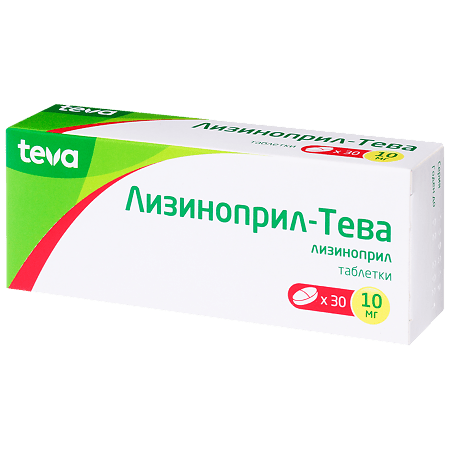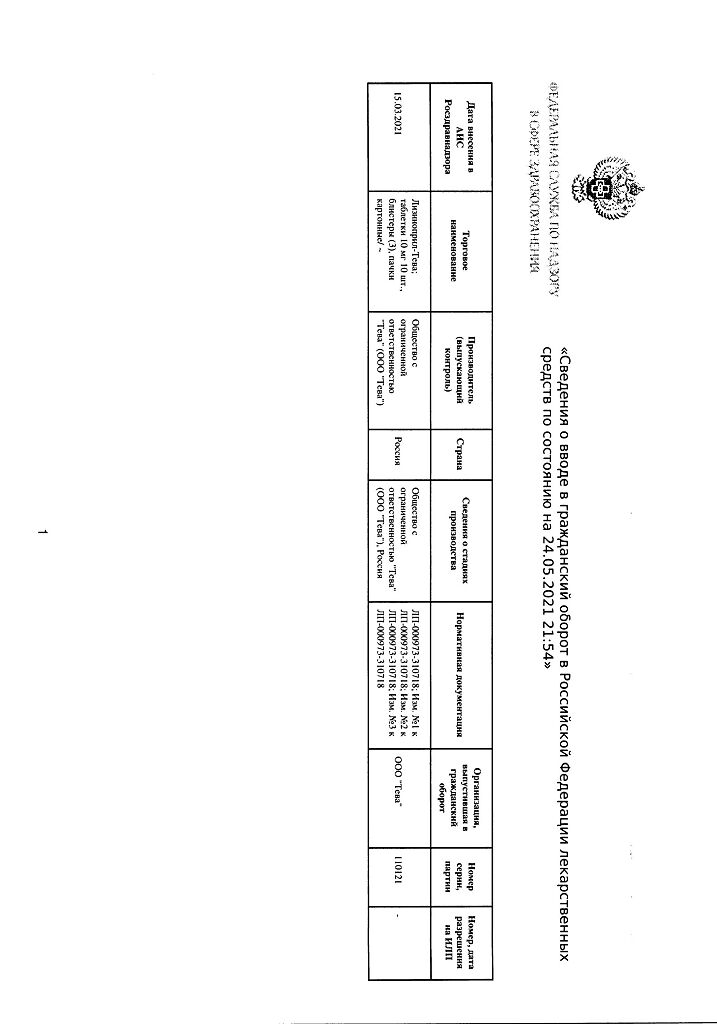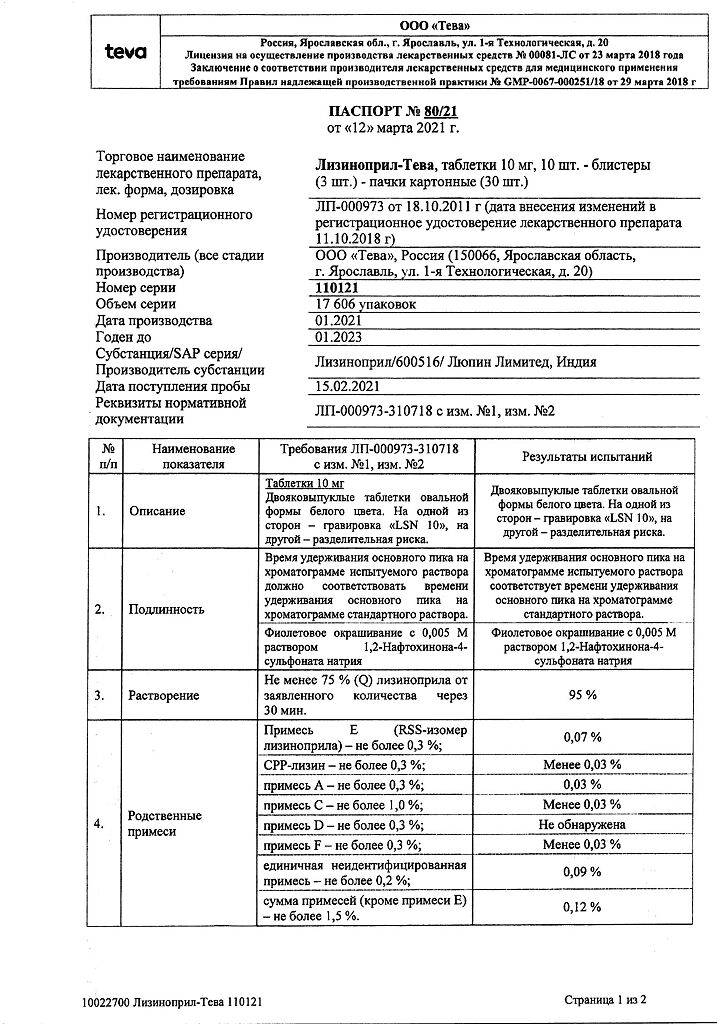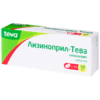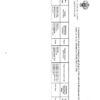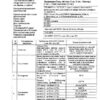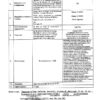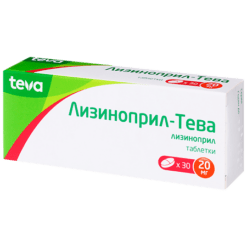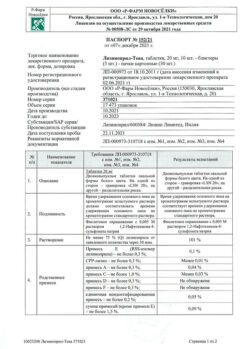No products in the cart.
Lisinopril-Teva, tablets 10 mg 30 pcs
€6.22 €5.53
Description
Pharmacotherapeutic group: angiotensin-converting enzyme inhibitor
ATX code: C09AA03
Pharmacological properties
Pharmacodynamics. Angiotensin-converting enzyme (ACE) inhibitor, reduces the formation of angiotensin II from angiotensin I. Decreased angiotensin II leads to a direct reduction in aldosterone release. Reduces bradykinin degradation and increases prostaglandin synthesis. Reduces total peripheral vascular resistance (TPR), blood pressure (BP), preload, pulmonary capillary pressure, causes an increase in minute blood volume and increases myocardial tolerance to exercise in patients with chronic heart failure. Dilates arteries more than veins. Some effects are attributed to effects on the renin-angiotensin-aldosterone system (RAAS). Long-term use reduces myocardial hypertrophy and resistive arterial wall hypertrophy. It improves the blood supply to the ischemic myocardium.
The ACE inhibitors prolong life expectancy in patients with chronic heart failure (CHF), slow the progression of left ventricular dysfunction in patients who have had acute myocardial infarction without clinical manifestations of heart failure. Onset of action of the drug is within 1 hour, the maximum antihypertensive effect is achieved after 6-7 hours and is maintained for 24 hours. The duration of the effect also depends on the dose taken. In arterial hypertension, the effect is noted in the first days after the start of treatment, a stable effect develops after 1-2 months of therapy. When lisinopril is abruptly withdrawn, no pronounced increase in BP has been observed.
Lisinopril decreases albuminuria. It does not affect blood glucose concentrations in patients with diabetes mellitus and does not lead to increased incidence of hypoglycemia.
Pharmacokinetics
Intake. After oral administration, lisinopril is absorbed from the gastrointestinal tract (GIT) by an average of 25%, but absorption can vary from 6 to 60%. Bioavailability is 29%. Maximum plasma concentration (Cmax) is reached after 7 h. Food intake does not affect the absorption of lisinopril.
Distribution. Lisinopril binds insignificantly to plasma proteins. Permeability through the blood-brain barrier and the placental barrier is low.
Metabolism. Lisinopril is not biotransformed in the body.
Elimination. It is excreted unchanged by the kidneys. The elimination half-life (T1/2) is 12.6 h. Clearance of lisinopril is 50 ml/min. Decrease in serum concentration of lisinopril occurs in two phases. The bulk of lisinopril is excreted during the initial alpha phase (effective T1/2 – 12 h), followed by the terminal distant beta phase (about 30 h).
Pharmacokinetics in selected patient groups
In patients with CHF the absorption and clearance of lisinopril is decreased and the bioavailability is 16%.
In patients with renal impairment (creatinine clearance (CK) less than 30 ml/min), lisinopril concentrations are several times higher than plasma concentrations in healthy volunteers, with increased time to reach Cmax in plasma and increased T1/2.
In elderly patients, the plasma concentration of the drug and the area under the concentration-time curve are 2 times greater than in younger patients.
In patients with cirrhosis the bioavailability of lisinopril is reduced by 30% and clearance by 50% compared to patients with normal liver function.
In elderly patients, the blood concentration of lisinopril is increased by an average of 60%.
Indications
Indications
• Arterial hypertension (in monotherapy or in combination with other antihypertensive drugs).
• Chronic heart failure (as part of combination therapy).
• Early treatment of acute myocardial infarction (in the first 24 hours with stable hemodynamic parameters to maintain these parameters and prevent left ventricular dysfunction and heart failure).
• Diabetic nephropathy (reduced albuminuria in patients with type 1 diabetes mellitus with normal blood pressure, and in patients with type 2 diabetes mellitus with arterial hypertension).
Pharmacological effect
Pharmacological effect
Pharmacotherapeutic group: angiotensin-converting enzyme inhibitor
ATX code: C09AA03
Pharmacological properties
Pharmacodynamics. An angiotensin-converting enzyme (ACE) inhibitor, reduces the formation of angiotensin II from angiotensin I. A decrease in angiotensin II leads to a direct decrease in the release of aldosterone. Reduces the degradation of bradykinin and increases the synthesis of prostaglandins. Reduces total peripheral vascular resistance (TPVR), blood pressure (BP), preload, pressure in the pulmonary capillaries, causes an increase in minute blood volume and an increase in myocardial load tolerance in patients with chronic heart failure. Dilates arteries more than veins. Some effects have been attributed to effects on the renin-angiotensin-aldosterone system (RAAS). With long-term use, hypertrophy of the myocardium and the walls of resistive arteries decreases. Improves blood supply to ischemic myocardium.
ACE inhibitors extend life expectancy in patients with chronic heart failure (CHF) and slow the progression of left ventricular dysfunction in patients who have suffered acute myocardial infarction without clinical manifestations of heart failure. The onset of action of the drug is after 1 hour, the maximum antihypertensive effect is achieved after 6-7 hours and lasts for 24 hours. The duration of the effect also depends on the size of the dose taken. In arterial hypertension, the effect is observed in the first days after the start of treatment, a stable effect develops after 1-2 months. therapy. When lisinopril was abruptly discontinued, no significant increase in blood pressure was observed.
Lisinopril reduces albuminuria. Does not affect the concentration of glucose in the blood in patients with diabetes mellitus and does not lead to an increase in cases of hypoglycemia.
Pharmacokinetics
Suction. After oral administration, lisinopril is absorbed from the gastrointestinal tract (GIT) by an average of 25%, but absorption can vary from 6 to 60%. Bioavailability is 29%. The maximum plasma concentration (Cmax) is reached after 7 hours. Food intake does not affect the absorption of lisinopril.
Distribution. Lisinopril is slightly bound to plasma proteins. Permeability through the blood-brain and placental barrier is low.
Metabolism. Lisinopril is not biotransformed in the body.
Excretion. It is excreted unchanged by the kidneys. The half-life (T1/2) is 12.6 hours. The clearance of lisinopril is 50 ml/min. The decrease in serum concentration of lisinopril occurs in two phases. The bulk of lisinopril is eliminated during the initial alpha phase (effective T1/2 – 12 hours), followed by a terminal late beta phase (about 30 hours).
Pharmacokinetics in selected patient groups
In patients with CHF, absorption and clearance of lisinopril are reduced, bioavailability is 16%.
In patients with renal failure (creatinine clearance (CC) less than 30 ml/min), the concentration of lisinopril is several times higher than the concentration in the blood plasma of healthy volunteers, and there is an increase in the time to reach Cmax in the blood plasma and an increase in T1/2.
In elderly patients, the concentration of the drug in the blood plasma and the area under the concentration-time curve are 2 times greater than in young patients.
In patients with liver cirrhosis, the bioavailability of lisinopril is reduced by 30% and clearance by 50% compared to patients with normal liver function.
In elderly patients, the concentration of lisinopril in the blood is increased by an average of 60%.
Special instructions
Special instructions
Most often, a pronounced decrease in blood pressure occurs when there is a decrease in blood volume caused by diuretic therapy, a decrease in the content of sodium chloride in food, dialysis, diarrhea or vomiting. Under the supervision of a physician, it is recommended to use the drug Lisinopril-Teva in patients with coronary artery disease, cerebrovascular insufficiency, in whom a sharp decrease in blood pressure can lead to myocardial infarction or stroke. The use of the drug Lisinopril-Teva can lead to impaired renal function and acute renal failure, which is usually reversible after discontinuation of the drug.
Transient arterial hypotension is not a contraindication for further use of the drug.
In case of renal artery stenosis (especially with bilateral stenosis or in the presence of stenosis of the artery of a single kidney), as well as with peripheral circulatory failure resulting from hyponatremia and hypovolemia, the use of the drug Lisinopril-Teva can lead to impaired renal function, acute renal failure, which is usually reversible after discontinuation of the drug.
The drug Lisinopril-Teva can be used simultaneously with standard therapy for acute myocardial infarction (thrombolytics, acetylsalicylic acid as an antiplatelet agent, beta-blockers).
The drug Lisinopril-Teva can be used simultaneously with intravenous administration of nitroglycerin or with the use of therapeutic transdermal nitroglycerin systems.
The use of Lisinopril-Teva is not recommended in patients who have suffered acute myocardial infarction if systolic blood pressure does not exceed 100 mm Hg.
During surgical interventions, as well as when using other drugs that cause a decrease in blood pressure, lisinopril, by blocking the formation of angiotensin II, can cause a pronounced, unpredictable decrease in blood pressure. Before surgery (including dental surgery), the surgeon/anesthesiologist should be informed about the use of an ACE inhibitor.
In elderly patients, the use of standard doses leads to higher concentrations of the drug in the blood, so special care is required when determining the dose, despite the fact that no differences in the antihypertensive effect of Lisinopril-Teva were identified in elderly and young patients.
Since the potential risk of agranulocytosis cannot be excluded, periodic monitoring of peripheral blood is required.
Angioedema of the face, extremities, lips, tongue, epiglottis and/or larynx, which may occur during any period of treatment, has rarely been reported in patients taking an ACE inhibitor, including lisinopril. In this case, treatment with the drug should be stopped as soon as possible, and the patient should be monitored until symptoms completely regress. Angioedema with laryngeal edema can be fatal. Swelling of the tongue, epiglottis or larynx can cause airway obstruction, so appropriate therapy (0.3-0.5 ml of 1:1000 epinephrine (adrenaline) solution subcutaneously) and/or measures to ensure airway patency should be immediately carried out. In cases where the swelling is localized only on the face and lips, the condition most often goes away without treatment, however, the use of antihistamines is possible. ACE inhibitors are more likely to cause the development of angioedema in patients of the Black race than in representatives of other races.
The risk of developing angioedema is increased in patients who have a history of angioedema not associated with previous treatment with ACE inhibitors.
The risk of developing angioedema also increases when used concomitantly with mTOR inhibitors.
Patients taking ACE inhibitors may very rarely develop life-threatening anaphylactoid reactions during desensitization to hymenoptera venom. This can be avoided by temporarily stopping ACE inhibitor treatment before each Hymenoptera desensitization procedure.
Anaphylactoid reactions have also been observed in patients on hemodialysis using high-flow dialysis membranes (AN69®) who are also taking ACE inhibitors. In such cases, the use of a different type of dialysis membrane or another antihypertensive agent should be considered.
In patients receiving insulin and oral hypoglycemic agents, blood glucose should be regularly monitored during the first month of ACE inhibitor therapy.
Very rarely, when using ACE inhibitors, a syndrome was observed that began with cholestatic jaundice and progressed to fulminant liver necrosis, sometimes with death. The mechanism of development of this syndrome is unknown. If jaundice appears during the use of the drug Lisinopril-Teva or a marked increase in the activity of “liver” transaminases, the drug is discontinued and the patient’s condition is monitored.
Cough has been reported when using ACE inhibitors. The cough is dry and prolonged, which disappears after stopping treatment with an ACE inhibitor. In the differential diagnosis of cough, cough caused by the use of an ACE inhibitor must also be taken into account.
Concomitant use of ACE inhibitors, ARB II or aliskiren increases the risk of hypotension, hyperkalemia and renal dysfunction (including acute renal failure).
Double blockade of the RAAS when using ACE inhibitors, ARB II or aliskiren is not recommended.
Concomitant use with drugs containing aliskiren is contraindicated in patients with diabetes mellitus and/or moderate or severe renal impairment (GFR less than 60 ml/min/1.73 m2 body surface area) and is not recommended in other patients.
Concomitant use of ACE inhibitors with ARA II receptor antagonists is contraindicated in patients with diabetic nephropathy and is not recommended in other patients.
In cases where dual blockade of the RAAS is considered absolutely necessary, treatment should occur only under the supervision of specialists and should be accompanied by careful and frequent monitoring of renal function, electrolytes and blood pressure. ACE inhibitors and ARB II should not be used simultaneously in patients with diabetic nephropathy.
Some patients taking ACE inhibitors, including lisinopril, experienced increased serum potassium concentrations. Risk factors for the development of hyperkalemia include renal failure, diabetes, hypoaldosteronism, concomitant use of potassium-sparing diuretics, as well as potassium supplements or potassium-containing table salt substitutes and other drugs that increase potassium levels in the blood (for example, heparin, co-trimoxazole).
The simultaneous use of ACE inhibitors with drugs containing sacubitril (neprilysin inhibitor) is contraindicated due to the risk of developing angioedema. The use of drugs containing sacubitril is possible no earlier than 36 hours after discontinuation of the ACE inhibitor. The use of an ACE inhibitor is possible no earlier than 36 hours after the last dose of drugs containing sacubitril.
Impact on the ability to drive vehicles and machinery
Caution should be exercised when taking the drug Lisinopril-Teva due to the fact that arterial hypotension, dizziness and drowsiness may develop, which can affect the ability to drive vehicles and work with potentially dangerous mechanisms.
Active ingredient
Active ingredient
Lisinopril
Composition
Composition
1 tablet contains: active ingredient lisinopril dihydrate (lisinopril) – 5.46 mg (5.00 mg); 10.92 mg (10.00 mg); 21.84 mg (20.00 mg); excipients: pregelatinized starch (12.00/12.00/12.00 mg), corn starch (40.00/40.00/40.00 mg), calcium hydrogen phosphate (anhydrous) (90.34/84.88/73.96 mg), mannitol (70.00/70.00/70.00 mg), magnesium stearate (2.20/2.20/2.20 mg).
Pregnancy
Pregnancy
The use of Lisinopril-Teva during pregnancy is contraindicated. If pregnancy is diagnosed, the drug should be stopped as soon as possible. Taking ACE inhibitors in the second and third trimesters of pregnancy has an adverse effect on the fetus (a marked decrease in blood pressure, renal failure, hyperkalemia, hypoplasia of the skull bones, and intrauterine death are possible). There is no data on the negative effect of the drug on the fetus when used in the first trimester. For newborns and infants who have been exposed in utero to ACE inhibitors, it is recommended to conduct careful monitoring for timely detection of a pronounced decrease in blood pressure, oliguria, and hyperkalemia. There is no data on the penetration of lisinopril into breast milk. If it is necessary to use the drug Lisinopril-Teva during lactation, breastfeeding should be discontinued.
Contraindications
Contraindications
Hypersensitivity to lisinopril, other components of the drug or other ACE inhibitors.
– History of angioedema (including from the use of other ACE inhibitors); hereditary angioedema and/or idiopathic angioedema.
– Age up to 18 years (efficacy and safety have not been established).
– Pregnancy.
– Breastfeeding period.
– Concomitant use with aliskiren and drugs containing aliskiren in patients with diabetes mellitus and/or moderate or severe renal impairment (glomerular filtration rate (GFR) less than 60 ml/min/1.73 m2 body surface area).
– Concomitant use with angiotensin II receptor antagonists (ARA II) in patients with diabetic nephropathy.
– Concomitant use with neutral endopeptidase inhibitors (for example, with drugs containing sacubitril) due to the high risk of developing angioedema.
With caution
Bilateral renal artery stenosis or stenosis of the artery of a single kidney with progressive azotemia; condition after kidney transplantation; renal failure; hemodialysis using high-flow dialysis membranes (AN69®); azotemia; hyperkalemia; aortic stenosis; hypertrophic obstructive cardiomyopathy; primary hyperaldosteronism; arterial hypotension; cerebrovascular diseases (including cerebrovascular insufficiency); coronary heart disease (CHD); coronary insufficiency; autoimmune connective tissue diseases (including scleroderma, systemic lupus erythematosus); inhibition of bone marrow hematopoiesis; conditions accompanied by a decrease in circulating blood volume (CBV) (including as a result of diarrhea, vomiting); use in patients on a salt-restricted diet; use in elderly patients; simultaneous use with potassium drugs, diuretics, other antihypertensive drugs, non-steroidal anti-inflammatory drugs (NSAIDs), lithium drugs, antacids, cholestyramine, ethanol, insulin, other hypoglycemic drugs, allopurinol, procainamide, gold drugs, neuroleptics, tricyclic antidepressants, barbiturates, beta-blockers, blockers slow calcium channels, co-trimoxazole, mTOR inhibitors (see sections “Interaction with other drugs” and “Special instructions”).
Side Effects
Side Effects
The most common side effects: dizziness, headache, fatigue, diarrhea, dry cough, nausea.
The incidence of side effects is classified according to the recommendations of the World Health Organization: very often – at least 10%; often – at least 1%, but less than 10%; infrequently – not less than 0.1%, but less than 1%; rarely – not less than 0.01%, but less than 0.1%; very rarely – less than 0.01%.
From the cardiovascular system: often – marked decrease in blood pressure, orthostatic hypotension; uncommon – acute myocardial infarction, tachycardia, palpitations, Raynaud’s syndrome; rarely – bradycardia, tachycardia, worsening symptoms of CHF, impaired atrioventricular conduction, chest pain.
From the central nervous system: often – dizziness, headache; uncommon – mood lability, paresthesia, sleep disturbances, stroke; rarely – confusion, asthenic syndrome, convulsive twitching of the muscles of the limbs and lips, drowsiness; frequency unknown – depression, fainting.
From the hematopoietic and lymphatic systems: rarely – decrease in hemoglobin, hematocrit; very rarely – leukopenia, neutropenia, agranulocytosis, thrombocytopenia, eosinophilia, erythropenia, hemolytic anemia, lymphadenopathy, autoimmune diseases, suppression of bone marrow function.
From the respiratory system: often – cough; infrequently – rhinitis; very rarely – sinusitis, bronchospasm, allergic alveolitis/eosinophilic pneumonia, shortness of breath.
From the digestive system: often – diarrhea, vomiting; uncommon – dyspepsia, taste changes, abdominal pain; rarely – dryness of the oral mucosa; very rarely – pancreatitis, jaundice (hepatocellular or cholestatic), hepatitis, liver failure, intestinal edema, anorexia.
From the skin: infrequently – itching, rash; rarely – angioedema of the face, limbs, lips, tongue, larynx, urticaria, alopecia, psoriasis; very rarely – increased sweating, vasculitis, pemphigus, photosensitivity, toxic epidermal necrolysis (Lyell’s syndrome), erythema multiforme, Stevens-Johnson syndrome, cutaneous pseudolymphoma.
From the urinary system: often – impaired renal function; uncommon – uremia, acute renal failure; very rarely – anuria, oliguria, proteinuria.
From the reproductive system: infrequently – impotence; rarely – gynecomastia.
Metabolism: very rarely – hypoglycemia.
From laboratory parameters: infrequently – increased concentration of urea in the blood, hypercreatininemia, hyperkalemia, increased activity of “liver” transaminases; rarely – hyperbilirubinemia, hyponatremia, increased erythrocyte sedimentation rate, false positive test results for antinuclear antibodies.
From the musculoskeletal system: rarely – arthralgia/arthritis, myalgia.
Other: rarely – when used simultaneously with gold preparations intravenously, a symptom complex has been described, including facial flushing, nausea, vomiting and decreased blood pressure (see section “Interaction with other drugs”).
Interaction
Interaction
Lisinopril should be used with caution simultaneously with potassium-sparing diuretics (spironolactone, triamterene, amiloride, eplerenone), potassium supplements, salt substitutes containing potassium, cyclosporine: the risk of hyperkalemia increases, especially with impaired renal function. Therefore, these combinations should be used only on the basis of an individual physician’s decision with regular monitoring of serum potassium levels and renal function.
When used simultaneously with diuretics and other antihypertensive drugs, the antihypertensive effect of lisinopril is enhanced.
When used simultaneously with NSAIDs (including selective cyclooxygenase-2 (COX-2) inhibitors), acetylsalicylic acid at a dose of more than 3 g/day, estrogens, and sympathomimetics, the antihypertensive effect of lisinopril is reduced. NSAIDs, including those from the group of selective COX-2 inhibitors, as well as ACE inhibitors, may increase serum potassium levels and, in some cases, worsen renal function. This effect is usually reversible.
Lisinopril slows down the elimination of lithium preparations, so when they are used simultaneously, a reversible increase in its concentration in the blood plasma occurs. This may increase the likelihood of adverse events, so serum lithium concentrations should be regularly monitored.
When used simultaneously with antacids and cholestyramine, the absorption of lisinopril from the gastrointestinal tract is reduced.
Ethanol enhances the effect of lisinopril.
When used simultaneously with insulin and oral hypoglycemic agents, the risk of developing hypoglycemia increases.
With simultaneous use of lisinopril with vasodilators, barbiturates, antipsychotics (neuroleptics), tricyclic antidepressants, slow calcium channel blockers, beta-blockers, the antihypertensive effect may be enhanced.
With the simultaneous use of ACE inhibitors and intravenous gold preparations (sodium aurothiamalate), a symptom complex has been described, including facial flushing, nausea, vomiting and decreased blood pressure.
Combined use with allopurinol, procainamide, and cytostatics can lead to leukopenia.
Dual blockade of the RAAS using angiotensin II receptor antagonists (ARA II), ACE inhibitors or aliskiren (renin inhibitor) is associated with an increased risk of hypotension, syncope, hyperkalemia and renal dysfunction (including acute renal failure) compared with monotherapy. Regular monitoring of blood pressure, kidney function and blood electrolytes is necessary. See also the “Special Instructions” section.
When used simultaneously with mTOR inhibitors, for example, sirolimus, everolimus, temsirolimus, the risk of developing angioedema, accompanied by swelling of the larynx or tongue, may increase, which can lead to airway obstruction (see section “Special Instructions”).
When used simultaneously with co-trimoxazole (trimethoprim + sulfamethoxazole), the risk of developing hyperkalemia may increase (see section “Special instructions”).
When used simultaneously with dipeptidyl peptidase type IV (DPP-IV) inhibitors (gliptins), for example, sitagliptin, saxagliptin, vildagliptin, linagliptin, the risk of developing angioedema increases.
When used simultaneously with racecadotril (an enkephalinase inhibitor), the risk of developing angioedema increases.
When ACE inhibitors are used simultaneously with drugs containing sacubitril (neprilysin inhibitor), the risk of developing angioedema increases, and therefore the simultaneous use of these drugs is contraindicated. ACE inhibitors should be prescribed no earlier than 36 hours after discontinuation of drugs containing sacubitril. Prescription of drugs containing sacubitril is contraindicated in patients receiving ACE inhibitors, as well as within 36 hours after the last dose of ACE inhibitors.
When used simultaneously with estramustine, the risk of developing angioedema also increases.
Observational studies have shown an increased incidence of angioedema in patients taking ACE inhibitors following the use of alteplase for thrombolytic therapy of ischemic stroke.
Overdose
Overdose
Symptoms: marked decrease in blood pressure, dryness of the oral mucosa, water-electrolyte imbalance, renal failure, increased breathing, tachycardia, palpitations, bradycardia, dizziness, anxiety, increased irritability, cough, drowsiness, urinary retention, constipation, collapse, hyperventilation.
Treatment: there is no specific antidote. Gastric lavage, use of enterosorbents and laxatives. Intravenous administration of 0.9% sodium chloride solution is indicated. In case of treatment-resistant bradycardia, it is necessary to use an artificial pacemaker. Monitoring of blood pressure and water and electrolyte balance is necessary. Hemodialysis is effective.
Storage conditions
Storage conditions
Store at a temperature no higher than 25 C. Keep out of the reach of children!
Shelf life
Shelf life
2 years. Do not use after expiration date.
Manufacturer
Manufacturer
Teva LLC (Russia), Russia
Additional information
| Shelf life | 2 years. Do not use after the expiration date. |
|---|---|
| Conditions of storage | Store at a temperature not exceeding 25 C. Keep out of reach of children! |
| Manufacturer | Teva LLC, Russia |
| Medication form | pills |
| Brand | Teva LLC |
Other forms…
Related products
Buy Lisinopril-Teva, tablets 10 mg 30 pcs with delivery to USA, UK, Europe and over 120 other countries.

